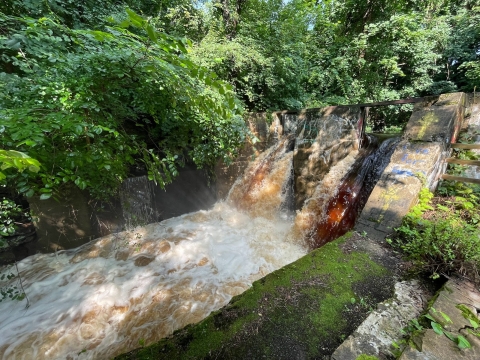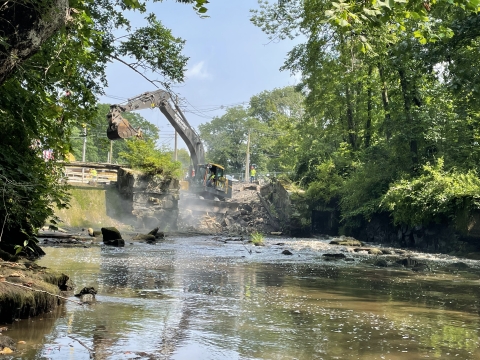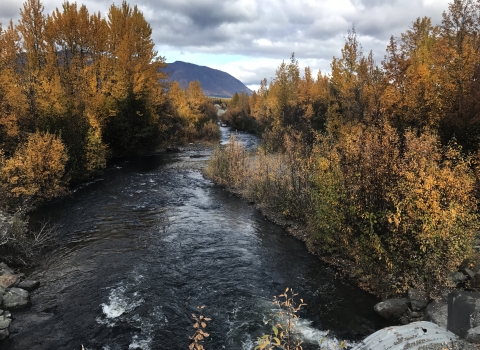Going, going — gone
Construction crews removed Bridgewater’s High Street Dam, which stood across the Town River for more than 100 years. The effort to remove failing or obsolete dams that are hazardous to local communities and prevent fish migration is being spearheaded by federal, state and local partners.
High Street Dam was the first barrier to migratory fish coming up the Taunton River from Narragansett Bay. The dam stood 12.5 feet high by 80 feet wide, had numerous structural problems, and was deemed a significant potential hazard that obstructed natural river flows and contributed to local flooding. Its important removal was funded in part by a $1.55 million investment through the Bipartisan Infrastructure Law Bipartisan Infrastructure Law
The Bipartisan Infrastructure Law (BIL) is a once-in-a-generation investment in the nation’s infrastructure and economic competitiveness. We were directly appropriated $455 million over five years in BIL funds for programs related to the President’s America the Beautiful initiative.
Learn more about Bipartisan Infrastructure Law and National Fish Passage Program.
Flood protection and river restoration
Just upstream, the accompanying and undersized High Street Bridge, built in 1790 and thought to be one of the oldest bridges still standing in the commonwealth, will be replaced with a new 55-foot, clear-span bridge that will better accommodate peak river flows and prevent flooding of the town’s roadway and adjacent private property.
The new bridge is designed to withstand a 500-year storm and climate change climate change
Climate change includes both global warming driven by human-induced emissions of greenhouse gases and the resulting large-scale shifts in weather patterns. Though there have been previous periods of climatic change, since the mid-20th century humans have had an unprecedented impact on Earth's climate system and caused change on a global scale.
Learn more about climate change projections through 2070. The river restoration will open 10 miles of river to alewife, blueback herring, American eel, sea lamprey and American shad fish species. Alewife will also benefit from 354 acres of spawning and rearing habitat in Lake Nippenicket.
New access to old waters
This project is the latest in a series of barrier removals on tributaries to the 40-mile National Wild and Scenic Taunton River — the longest, undammed, coastal river in New England. On the nearby Mill River in Taunton, removal of the Whittenton Mill Pond, Hopewell Mills and West Britannia dams and construction of a fishway at Lake Sabbatia reconnected 30 miles and 560 acres of spawning and rearing habitats with the larger Taunton River and Narragansett Bay system. Populations of migratory fish have increased substantially.
Thank you partners
This project is funded and supported by the following partners: the Massachusetts Executive Office of Energy and Environmental Affairs’ Dam and Seawall Repair or Removal Fund and Municipal Vulnerability Preparedness Program; the Massachusetts Department of Fish and Game’s Divisions of Ecological Restoration and Marine Fisheries; the National Fish and Wildlife Foundation; Town of Bridgewater; the National Oceanic and Atmospheric Administration; The Nature Conservancy; the Taunton River Stewardship Council; and the private dam owner.







